In the stillness of the evening, after the boats have been put away, and the darkness settles in, you'll often hear them before you see them — if you see them at all. Their memorable, haunting cries are often what connect people to loons and to the lakes and ponds they return to each year.
It's also why their black-and-white patterned image adorns Maine license plates.
But for the purposes of Maine Audubon's annual loon count, the sound of the loon isn't enough. You have to actually see one.
For 40 years, the count has provided important data about the health of the bird population. It's an ambitious undertaking that happens early in the morning on the third Saturday in July. Hundreds of volunteers fan out across lakes and ponds in canoes, kayaks and motorboats to search for a much loved symbol of Maine: the common loon.
And this year, the numbers could be affected by heavy rain and high water.
"If a loon flies over us we can't count it, it's only loons in the water," says Diane Bruni, who with her husband, Jeff, and grandson, Sawyer, is among the 40 volunteers who are counting loons on Sebago Lake, the second largest lake in Maine.
At precisely 7 a.m., they set off from their dock. The area they're surveying happens to be located directly in front of their house.

Across the state 1,600 volunteers are doing exactly the same thing at exactly the same time. They have just 30 minutes to record their sightings. It's a way to make sure that loons aren't counted twice.
Showers and thunderstorms in the forecast hold off on this overcast July morning. But the water is choppy. The loons are elusive and the half hour passes quickly.
"So where we're sitting right now, we're in the middle of Jordan Bay and not seeing many boats but also, still no loons," Diane Bruni says.
This is only the second year that Sebago has been included in the annual loon count. Because the lake is so large, coordinator Brad McCurtain says it has been challenging to find enough volunteers.
"It's 30,000 acres. There are better than 100 miles of shorefront, and so Maine Audubon divided it into 49 survey areas, and they range from a few hundred acres up to 2,000 acres, which is a lot of territory to cover," he says.
Every part of the lake has to be surveyed, or McCurtain says the numbers can't be entered.
Last year there were 32 adults and one chick counted on Sebago. Around the state, the final tally was 3,057 adults and 298 chicks. But much of northern Maine isn't covered. That includes Moosehead, the largest lake in the state.

Still, the count is a way for Maine Audubon to document trends and identify potential threats such as pollution, boat strikes and habitat loss. This year high water is a concern.
"We've been receiving kind of some anecdotal reports that high water levels have washed out nests or caused loons not to be able to find their natural nests that maybe they've nested on years before," says Hannah Young, the community science manager for Maine Audubon.
Young says there have also been reports of eggs in the water instead of on shore which could affect chick production.
"The great thing about the count is that we are looking at trends over time so we do expect kind of year to year fluctuations and so we're not raising alarm bells yet or anything like that," she says.
Young says in recent years the numbers have been holding steady.

Back on Sebago Lake, counting has concluded, and the Brunis' friends and fellow volunteers, Chick and Norma Marks swing by to compare notes. Both groups tallied zero sightings, but neither are discouraged by the outcome. Chick Marks says they know the loons are out there.
"I've probably seen five or six of them easily in one day. We love seeing them. Absolutely love it," Marks says.
Maine Audubon expects to release the final tally for the state by the end of the year.



